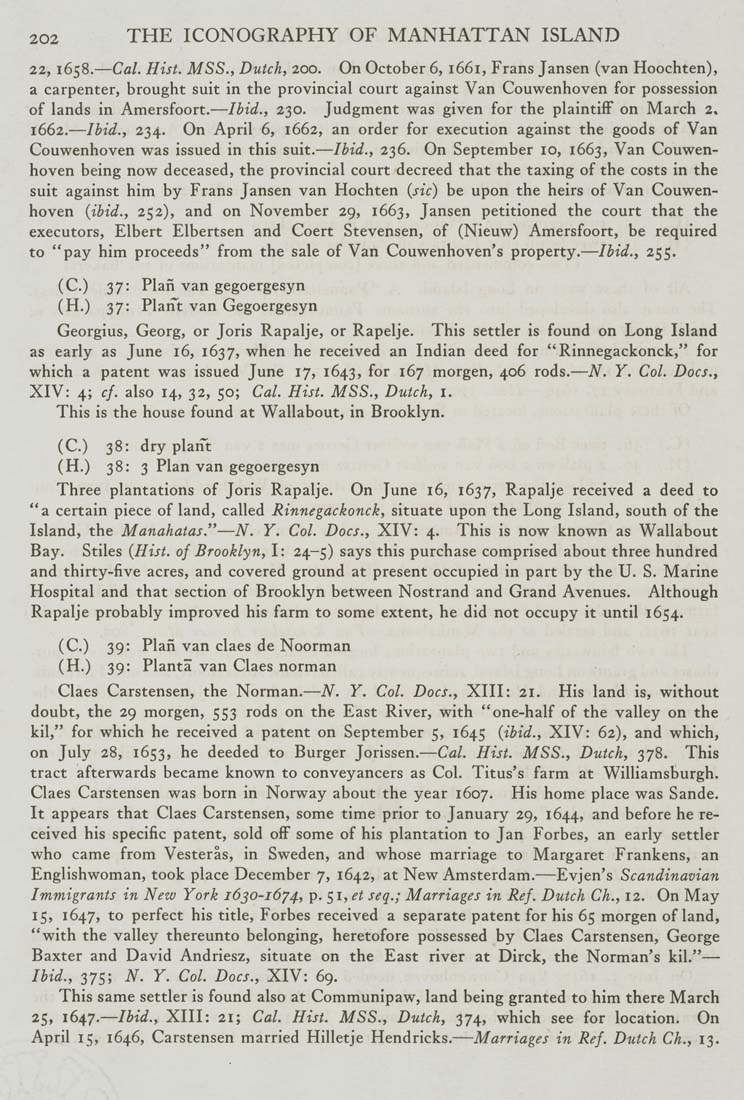202 THE ICONOGRAPHY OF MANHATTAN ISLAND
22, 1658.—Cal. Hist. MSS., Dutch, 200. On October 6, 1661, Frans Jansen (van Hoochten),
a carpenter, brought suit in the provincial court against Van Couwenhoven for possession
of lands in Amersfoort.—Ibid., 230. Judgment was given for the plaintiff on March 2,
1662.—Ibid., 234. On April 6, 1662, an order for execution against the goods of Van
Couwenhoven was issued in this suit.—Ibid., 236. On September 10, 1663, Van Couwen¬
hoven being now deceased, the provincial court decreed that the taxing of the costs in the
suit against him by Frans Jansen van Hochten (sic) be upon the heirs of Van Couwen¬
hoven {ibid., 252), and on November 29, 1663, Jansen petitioned the court that the
executors, Elbert Elbertsen and Coert Stevensen, of (Nieuw) Amersfoort, be required
to "pay him proceeds" from the sale of Van Couwenhoven's property.—Ibid., 255.
(C.) 37: Plaii van gegoergesyn
(H.) 37: Plant van Gegoergesyn
Georgius, Georg, or Joris Rapalje, or Rapelje. This settler is found on Long Island
as early as June 16, 1637, when he received an Indian deed for "Rinnegackonck," for
which a patent was issued June 17, 1643, for 167 morgen, 406 rods.—N. Y. Col. Docs.,
XIV: 4; cf. also 14, 32, 50; Cal. Hist. MSS., Dutch, I.
This is the house found at Wallabout, in Brooklyn.
(C.) 38: dry plant
(H.) 38: 3 Plan van gegoergesyn
Three plantations of Joris Rapalje. On June 16, 1637, Rapalje received a deed to
"a certain piece of land, called Rinnegackonck, situate upon the Long Island, south of the
Island, the Manahatas."—A^. Y. Col. Docs., XIV: 4. This is now known as Wallabout
Bay. Stiles {Hist, of Brooklyn, I: 24-5) says this purchase comprised about three hundred
and thirty-five acres, and covered ground at present occupied in part by the U. S. Marine
Hospital and that section of Brooklyn between Nostrand and Grand Avenues. Although
Rapalje probably improved his farm to some extent, he did not occupy it until 1654.
(C.) 39: Plaii van claes de Noorman
(H.) 39: Planta van Claes norman
Claes Carstensen, the Norman.—N. Y. Col. Docs., XIII: 21. His land is, without
doubt, the 29 morgen, 553 rods on the East River, with "one-half of the valley on the
kil," for which he received a patent on September 5, 1645 {ibid., XIV: 62), and which,
on July 28, 1653, he deeded to Burger Jorissen.—Cal. Hist. MSS., Dutch, 378. This
tract afterwards became known to conveyancers as Col. Titus's farm at Williamsburgh.
Claes Carstensen was born in Norway about the year 1607. His home place was Sande.
It appears that Claes Carstensen, some time prior to January 29, 1644, and before he re¬
ceived his specific patent, sold off some of his plantation to Jan Forbes, an early settler
who came from Vesteras, in Sweden, and whose marriage to Margaret Frankens, an
Englishwoman, took place December 7, 1642, at New Amsterdam.—Evjen's Scandinavian
Immigrants in New York i6jo-i6y4, p. 51, ci seq.; Marriages in Ref. Dutch Ch., 12. On May
15, 1647, to perfect his title, Forbes received a separate patent for his 65 morgen of land,
"with the valley thereunto belonging, heretofore possessed by Claes Carstensen, George
Baxter and David Andriesz, situate on the East river at Dirck, the Norman's kil."—■
Ibid., 375; N. Y. Col. Docs., XIV: 69.
This same settler is found also at Communipaw, land being granted to him there March
25, 1647.—Ibid., XIII: 21; Cal. Hist. MSS., Dutch, 374, which see for location. On
April 15, 1646, Carstensen married Hilletje Hendricks.—Marriages in Ref. Dutch Ch., 13.
|








